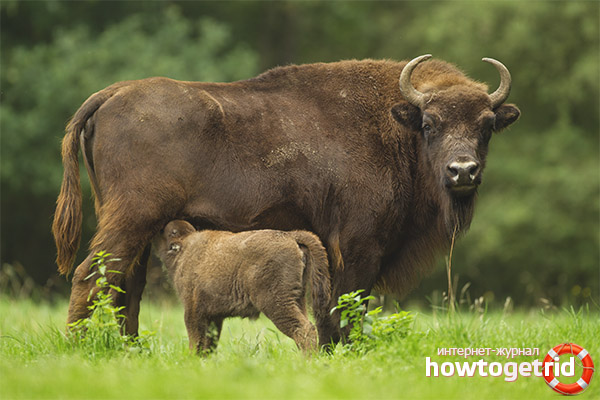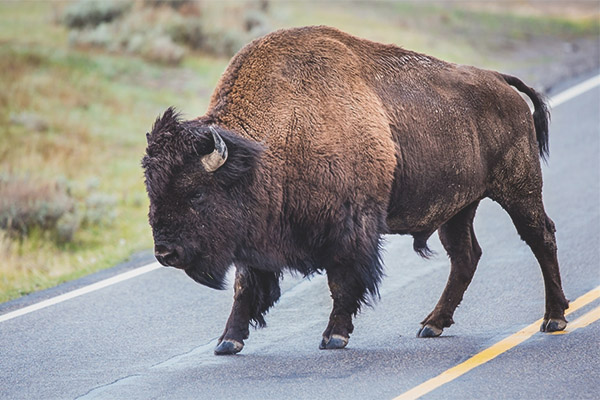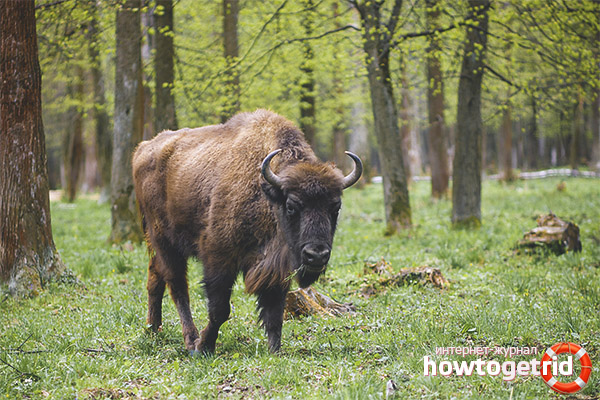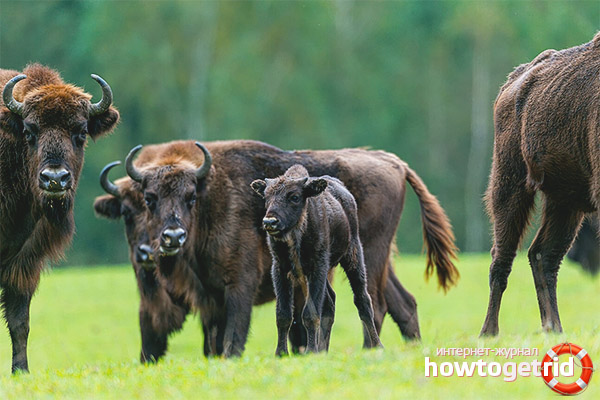The content of the article
Bison - a species of mammal of the genus bison, is considered one of the species of wild bull. Refers to the artiodactyl, family of bull. It has an external similarity with the American bison and tour. Quite a large animal from the family of artiodactyls. At this time, this species is considered endangered, listed in the Red Book.
Bison is one of the last remaining representatives of wild bulls. The closest similar species is bison. Bison and bison can interbreed, the result is the appearance of bison. These species are often compared, they are similar in appearance and structure, but the bison looks bigger and more powerful than a bison.
The appearance of the animal
The weight of an adult individual is approximately a ton, the ancestors of modern bison were much more powerful and their weight reached more than one ton. Now almost all animals are smaller, this is due to the gradual extermination of this species. The bison's height at the withers is more than 180 centimeters.The length can be up to 300-330 centimeters. Bison females are usually smaller than males.
The front of the bison is massive, the hump unites the neck and the back of the animal. The back is a bit smaller in size. Bulky and rather wide chest, strong legs with bulging hooves. The front legs are often a little shorter than the rear. Legs strong. In general, an animal of this species is very strong and enduring, able to cover long distances. The bison have a wide and low forehead, horns wide apart. The horns are round and smooth in shape, their length can be up to 65 centimeters. The horns of bison are black, sharp, with a collapse of about 70 cm. In older animals, they may be blunted or knocked down. The head of an animal of small size, when compared with the body, is low, more often the tail and the back part are higher. A terrible look to this animal gives a beard and voluminous mane. Often the color of the hair on the head and beard is darker than the rest of the color.
The scent and auditory receptors are much more developed than the visual ones, although the ears of the bison are small and hidden by voluminous hair. Wool is most often brown in color, maybe with a reddish tint. Young bulls may have a brighter color.
The coat of the animal, like the color, varies depending on the summer or winter period. The coat is thick, short, but well protects the animal from cold and rain. The bison is almost all covered with hair, with the exception of the upper lip and nostrils. Longer hair is in the neck and hump. The eyes are small, mobile, black, the eyelashes are long, black. The jaw and the shape of the teeth are similar in structure to other types of ruminants. Dark-colored mouth, including tongue and lips. An adult animal of this species has 32 teeth - incisors, molars and premolars, as well as canines.
Bison seldom makes sounds, mostly they look like rumblings, in an enraged state sniffles loudly and snorts.
Habitats
The habitat of these animals was originally from the Iberian Peninsula to the western region of Siberia, but soon the bison began to live only in dense forests. Bison also lived in England and in the south of Scandinavia. Earlier, the Caucasian bison known in the Caucasus mountains were also known, but they were subjected to extermination. Most bison can be seen in deciduous coniferous or mixed forests.Previously, the habitat of these animals was open terrain.
Bison live gregariously, usually not more than 20 individuals in a single herd, consisting of young bulls, calves and cows. Males are in the herd only during the breeding season. Nowadays they live in Russia, Moldova, Belarus, Spain and other countries on the territory of nature reserves. In Russia, it is Belovezhskaya Pushcha, national parks and nurseries.
Earlier, bison were hunted, most of them were also exterminated during the First World War. Despite attempts to save the population, at the moment the animal is considered rare and close to extinction. In our time, attempts are being made to preserve and breed bison, most of them live in zoos and nurseries.
Subspecies
- Plain bison.
- Caucasian bison.
- Carpathian or Hungarian bison.
The flat bison lived in England, Scandinavia and in the west of Siberia. At this time, only this species was preserved due to breeding and breeding in protected areas, the rest were exterminated. The flat bison are sometimes called the Belovezhskaya bison.Bison of Caucasian origin were smaller, with curly hair. Purebred animals from the Caucasus were threatened with extinction, and the last representative of wild Caucasian bison was destroyed in 1926. All modern individuals occurred as a result of breeding in reserves and zoos, where there were representatives of this species. Carpathian bison and its existence causes numerous disputes among specialists, it is considered exterminated in the 18th century.
Lifestyle
Due to its large size, a bison may seem clumsy and slow, but it is not. With the manifestation of aggression the animal is very dangerous. Bison strikes blows with horns, and the strength of these blows is quite high. An obstacle or any hedge will not stop an angry animal. If a bison shakes its head and snorts, takes an attacking pose - it means that it is ready to pounce on the enemy. Animals themselves rarely act as aggressors, preferring to hide in the forest from people and danger.
The animal is at rest in the daytime, bison usually graze, or lie in the sun, chewing the cud. The herd usually consists of young individuals and females, the males live alone or in small groups.Individuals can unite only if danger threatens, for example, it is necessary to protect the herd from predators or in the cold winter time. The herd is headed by an experienced female bison.
Usually bison do not threaten a person; one can say they avoid meeting people and try not to fall into sight. The exception may be the female, standing up to protect the offspring, she can be quite aggressive, so you should not get close to her.
Graze animals prefer in selected areas, close to the watering or riverbed. If the weather is dry and hot, then the bison go into the shady thickets of the forest. By nature, animals are very hardy and strong, they even know how to swim. They can overcome decent distances in search of a new pasture or habitat. Bison can run pretty fast, despite its weight and large dimensions, but for short distances.
The enemies
The danger for animals is a wolf or a bear, as well as lynx and similar predators. Bison are protected from predator attacks, creating a circle within which there are cubs and the weakest individuals.An adult bison can overpower a predator alone, but young animals or weak animals are more at risk.
Nutrition
Bison is a herbivore mammal, eating thin branches, grass, leaves, tree bark. They can also eat mushrooms, some berries or acorns. In reserves or zoos they are additionally fed with hay. In winter, animals dig in the snow and topsoil in search of roots and conifer needles. An adult bull may need up to 45 kg of food per day, there are known cases of teeth attacking other animals if they try to take food. In general, bison do not communicate well with other herbivores, for example, deer, elk, cases of attack are not rare.
Reproduction and development

The mating season at bison begins in the summer or early fall. Males appear in the herds, which begin to compete and fight for females. At the beginning of the battle for the female, the animals defiantly snort, swing their horns, dig the ground. Usually bison strike hard with their horns, collide head-on and try to drive the opponent away. Sometimes fights are not only a demonstration of strength, but also leave a defeated bison with serious injuries.A defeated male will usually admit defeat if the head is bowed and moves away.
A pregnant female walks about 9 months, childbirth usually occurs at the beginning of summer. A healthy female bison can give birth almost every year. Usually one cub is born, very rarely two calves. After a few hours, the calf can stand up. Calves for several years remain in the herd, then upon reaching adulthood the young bull leaves the herd. On average, the life of a bison is about 20 years; in the reserve, the life span can be extended to 27-30 years.
A calf is born weighing up to 20 kilograms; for 7 months or a year, the female feeds it with milk. Already after a few weeks, the calf can eat plant food, but it is still strongly attached to the mother and follows her and her smell.
Mature bison is considered after 6 months or more. After 5-6 years, the growth of the animal stops.
Bison in history and culture
The image of the bison is often used in literature, on emblems and drawings as a symbol of power and endurance. The first mention of a bison occurred in cave paintings and in medieval works of art.In heraldry, bison are depicted as a symbol of labor and power. In some countries, popular sculptures and figurines depicting this animal. The same image of this animal can be found on stamps, bank notes and coins. Bison is often mentioned in the names of various sports teams and other things. This animal is also a symbol of Belarus.
Video: bison (Bison bonasus)













To send